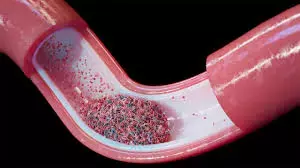- Home
- Medical news & Guidelines
- Anesthesiology
- Cardiology and CTVS
- Critical Care
- Dentistry
- Dermatology
- Diabetes and Endocrinology
- ENT
- Gastroenterology
- Medicine
- Nephrology
- Neurology
- Obstretics-Gynaecology
- Oncology
- Ophthalmology
- Orthopaedics
- Pediatrics-Neonatology
- Psychiatry
- Pulmonology
- Radiology
- Surgery
- Urology
- Laboratory Medicine
- Diet
- Nursing
- Paramedical
- Physiotherapy
- Health news
- Fact Check
- Bone Health Fact Check
- Brain Health Fact Check
- Cancer Related Fact Check
- Child Care Fact Check
- Dental and oral health fact check
- Diabetes and metabolic health fact check
- Diet and Nutrition Fact Check
- Eye and ENT Care Fact Check
- Fitness fact check
- Gut health fact check
- Heart health fact check
- Kidney health fact check
- Medical education fact check
- Men's health fact check
- Respiratory fact check
- Skin and hair care fact check
- Vaccine and Immunization fact check
- Women's health fact check
- AYUSH
- State News
- Andaman and Nicobar Islands
- Andhra Pradesh
- Arunachal Pradesh
- Assam
- Bihar
- Chandigarh
- Chattisgarh
- Dadra and Nagar Haveli
- Daman and Diu
- Delhi
- Goa
- Gujarat
- Haryana
- Himachal Pradesh
- Jammu & Kashmir
- Jharkhand
- Karnataka
- Kerala
- Ladakh
- Lakshadweep
- Madhya Pradesh
- Maharashtra
- Manipur
- Meghalaya
- Mizoram
- Nagaland
- Odisha
- Puducherry
- Punjab
- Rajasthan
- Sikkim
- Tamil Nadu
- Telangana
- Tripura
- Uttar Pradesh
- Uttrakhand
- West Bengal
- Medical Education
- Industry
Post-Thrombectomy Intra-Arterial Tenecteplase Shows Promise: Study

Researchers have found in a new study, among patients with acute large vessel occlusion (LVO) presenting between 4.5 and 24 hours after symptom onset, intra-arterial tenecteplase administered after successful thrombectomy was associated with improved neurological outcomes at 90 days, without increasing the risk of symptomatic intracranial hemorrhage (sICH) or mortality. However, lack of support from secondary efficacy outcomes suggests the need for further clinical trials to confirm these findings.
The role of intra-arterial tenecteplase for acute large vessel occlusion (LVO) stroke after successful endovascular therapy is uncertain.
A study was done to assess the efficacy and safety of intra-arterial tenecteplase in patients with successful endovascular therapy (defined as a score on the expanded Thrombolysis in Cerebral Infarction [eTICI] scale of 2b to 3) after endovascular therapy.
This was a prospective, open-label, blinded end point, randomized trial. Recruitment took place between February 16, 2023, and March 23, 2024, with final follow-up on July 4, 2024. The study was conducted across 19 centers in China. Patients with acute anterior circulation LVO treated between 4.5 and 24 hours from the time that the patient was last known to be well were included. After successful endovascular recanalization, defined as eTICI 2b or greater, patients were randomized to receive intra-arterial tenecteplase at 0.125 mg/kg (n = 126) or standard medical treatment (n = 129) The primary end point was excellent outcome at 90 days, defined as modified Rankin Scale (mRS) score of 0 to 1 (range, 0 [no symptoms] to 6 [death]). There were a total of 7 secondary efficacy end points (mRS score of 0-1 at 90 days, mRS score at 90 days, mRS score of 0-2 at 90 days, mRS score of 0-3 at 90 days, National Institutes of Health Stroke Scale score of 0-1 or improved ≥10 points at 36 hours, European Quality of Life Visual Analogue Scale score at 90 days, time to maximum volume > 6 s at 24 hours, and infarct core volume change from baseline) and 3 safety end points, including symptomatic intracranial hemorrhage (sICH) within 48 hours, any intracranial hemorrhage within 48 hours, and all-cause mortality within 90 days.
RESULTS Among 256 patients who were randomized (median [IQR] age, 71.6 [61.3-79.2] years; 113 [44.1%] females), 255 (99.6%) completed the trial. The rate of patients with an mRS score of 0 to 1 at 90 days was 40.5% in the intra-arterial tenecteplase group (n = 51) and 26.4% in the standard medical treatment group (n = 34) (relative risk, 1.44 [95% CI, 1.06-1.95]; P = .02). Of 7 prespecified secondary efficacy end points, none showed a significant difference. Intra-arterial tenecteplase after endovascular therapy did not increase the incidence of sICH within 48 hours after treatment compared with standard medical treatment (5.6% vs 6.2%; relative risk, 0.95 [95% CI, 0.36-2.53]; P = .92). Mortality at 90 days was 21.4% with intra-arterial tenecteplase and 21.7% with standard medical treatment (relative risk, 0.76 [95% CI, 0.40-1.43]; P = .78). In patients with acute LVO presenting between 4.5 and 24 hours of symptom onset, intra-arterial tenecteplase after successful thrombectomy had a greater likelihood of excellent neurological outcome at 90 days without increasing the risk of sICH or mortality. However, because none of the secondary efficacy analyses supported the primary finding, further trials are needed to confirm the results.
Reference:
Miao Z, Luo G, Song L, et al. Intra-arterial Tenecteplase for Acute Stroke After Successful Endovascular Therapy: The ANGEL-TNK Randomized Clinical Trial. JAMA. Published online July 05, 2025. doi:10.1001/jama.2025.10800
Dr. Shravani Dali has completed her BDS from Pravara institute of medical sciences, loni. Following which she extensively worked in the healthcare sector for 2+ years. She has been actively involved in writing blogs in field of health and wellness. Currently she is pursuing her Masters of public health-health administration from Tata institute of social sciences. She can be contacted at editorial@medicaldialogues.in.
Dr Kamal Kant Kohli-MBBS, DTCD- a chest specialist with more than 30 years of practice and a flair for writing clinical articles, Dr Kamal Kant Kohli joined Medical Dialogues as a Chief Editor of Medical News. Besides writing articles, as an editor, he proofreads and verifies all the medical content published on Medical Dialogues including those coming from journals, studies,medical conferences,guidelines etc. Email: drkohli@medicaldialogues.in. Contact no. 011-43720751


